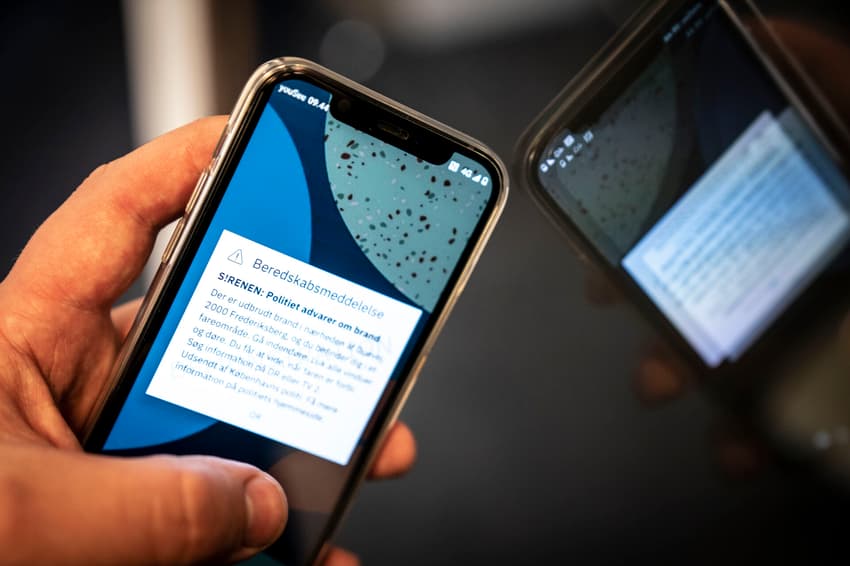Why did one in three phones in Denmark not receive mobile siren test?

Around one in three people in Denmark did not receive a new mobile siren sent out by authorities in a national test on May 3rd.
In addition to the regular test of physical mast sirens, authorities in Denmark tested a new digital warning system for the first time during the annual drill, which takes place on the first Monday in May each year.
The purpose of both types of siren is to enable authorities to warn the population if there is an emergency situation.
The new system, which is named S!RENEN, enables authorities to send siren sounds and warning messages to smartphones.
Many mobile phone users received the test alerts as planned but others did not.
READ ALSO: Denmark’s mobile sirens fail to reach all phones
The Danish Emergency Management Agency (Beredskabstyrelsen, DEMA), said that 64 percent of respondents to a survey said they had received the digital siren, which consisted of an audible alert sound as well as a text message.
Some 33 percent said they didn’t receive the alert.
DEMA said it is now investigating why such a large proportion of the public did not receive the alert on their devices. Mobile users cannot prevent their phones from receiving it through their settings and devices do not need any app to receive the alert.
“DEMA’s initial conclusion is that a broad cause is that the operating system on telephones was not up to date,” the agency said on its website.
“Another reason is that older telephones do not receive the warnings,” it said.
Another suspected reason for the issue is that some phones may have been connected to the 3G network, which unlike the newer 4G and 5G is not compatible with the warning alerts.
Emergencies in which the sirens are intended for use outside of tests can include the presence of chemical gases, radiation or hazardous smoke. They can be used to warn the public nationally or within a specified geographical area.
The May 3rd test was national, meaning the intention was for all phones to receive the alert.
DEMA has previously stated that iPhones needed operating system 16.4 or newer, after many users initially reported the alert hadn’t been delivered to their iPhones.
The agency expects to complete its evaluation of the test this summer. The survey referred to by DEMA was conducted by Megafon on the agency’s behalf and is based on responses from 1,061 people.
Comments
See Also
In addition to the regular test of physical mast sirens, authorities in Denmark tested a new digital warning system for the first time during the annual drill, which takes place on the first Monday in May each year.
The purpose of both types of siren is to enable authorities to warn the population if there is an emergency situation.
The new system, which is named S!RENEN, enables authorities to send siren sounds and warning messages to smartphones.
Many mobile phone users received the test alerts as planned but others did not.
READ ALSO: Denmark’s mobile sirens fail to reach all phones
The Danish Emergency Management Agency (Beredskabstyrelsen, DEMA), said that 64 percent of respondents to a survey said they had received the digital siren, which consisted of an audible alert sound as well as a text message.
Some 33 percent said they didn’t receive the alert.
DEMA said it is now investigating why such a large proportion of the public did not receive the alert on their devices. Mobile users cannot prevent their phones from receiving it through their settings and devices do not need any app to receive the alert.
“DEMA’s initial conclusion is that a broad cause is that the operating system on telephones was not up to date,” the agency said on its website.
“Another reason is that older telephones do not receive the warnings,” it said.
Another suspected reason for the issue is that some phones may have been connected to the 3G network, which unlike the newer 4G and 5G is not compatible with the warning alerts.
Emergencies in which the sirens are intended for use outside of tests can include the presence of chemical gases, radiation or hazardous smoke. They can be used to warn the public nationally or within a specified geographical area.
The May 3rd test was national, meaning the intention was for all phones to receive the alert.
DEMA has previously stated that iPhones needed operating system 16.4 or newer, after many users initially reported the alert hadn’t been delivered to their iPhones.
The agency expects to complete its evaluation of the test this summer. The survey referred to by DEMA was conducted by Megafon on the agency’s behalf and is based on responses from 1,061 people.
Join the conversation in our comments section below. Share your own views and experience and if you have a question or suggestion for our journalists then email us at [email protected].
Please keep comments civil, constructive and on topic – and make sure to read our terms of use before getting involved.
Please log in here to leave a comment.